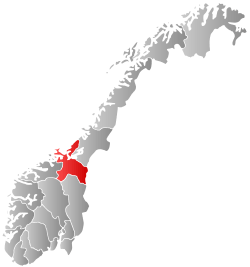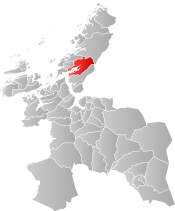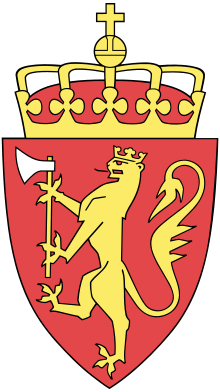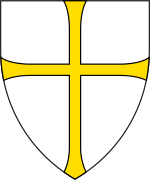Stjørna
Stjørna is a former municipality in the old Sør-Trøndelag county in Norway. The municipality existed from 1899 until its dissolution in 1964. The 322-square-kilometre (124 sq mi) municipality encompassed the land surrounding the Stjørnfjorden in what is now the municipalities of Ørland and Indre Fosen in Trøndelag county. The administrative centre of Stjørna was the village of Husbysjøen. The municipality of Stjørna also included the villages of Høybakken, Råkvåg, and Fevåg. The main church for the municipality was Stjørna Church which is now called Heggvik Church.[2]
Stjørna herred Skjørn | |
|---|---|
 Sør-Trøndelag within Norway | |
 Stjørna within Sør-Trøndelag | |
| Coordinates: 63°44′50″N 10°06′25″E | |
| Country | Norway |
| County | Sør-Trøndelag |
| District | Fosen |
| Established | 1 Jan 1899 |
| Disestablished | 1 Jan 1964 |
| Administrative centre | Husbysjøen |
| Area | |
| • Total | 322 km2 (124 sq mi) |
| *Area at municipal dissolution. | |
| Population (1964) | |
| • Total | 2,544 |
| • Density | 7.9/km2 (20/sq mi) |
| Demonym(s) | stjørnværing[1] |
| Time zone | UTC+01:00 (CET) |
| • Summer (DST) | UTC+02:00 (CEST) |
| ISO 3166 code | NO-1626 |
| Preceded by | Bjugn in 1899 |
| Succeeded by | Bjugn & Rissa in 1964 |
History
The municipality of Skjørn was established on 1 January 1899 when the old municipality of Bjugn was split into three separate municipalities: Bjugn (population: 1,256), Skjørn (population: 2,166), and Nes (population: 1,285). In 1918, the spelling of the name was changed from Skjørn to Stjørna.
During the 1960s, there were many municipal mergers across Norway due to the work of the Schei Committee. On 1 January 1964, the northern part of the municipality (Nord-Stjørna) (population: 676) was merged with the neighboring municipalities of Bjugn (population: 1,240), Nes (population: 1,107), and Jøssund (population: 1,917) to form a new, larger municipality of Bjugn. The southern part of Stjørna municipality (Sør-Stjørna) (population: 1,868) was merged with the neighboring municipality of Rissa (population: 3,264) and most of the municipality of Stadsbygd (population: 1,616) to form a new, larger municipality of Rissa.[3]
Government
All municipalities in Norway, including Stjørna, are responsible for primary education (through 10th grade), outpatient health services, senior citizen services, unemployment and other social services, zoning, economic development, and municipal roads. The municipality is governed by a municipal council of elected representatives, which in turn elects a mayor.[4]
Municipal council
The municipal council (Herredsstyre) of Stjørna was made up of representatives that were elected to four year terms. The party breakdown of the final municipal council was as follows:
| Party Name (in Norwegian) | Number of representatives | |
|---|---|---|
| Labour Party (Arbeiderpartiet) | 7 | |
| Conservative Party (Høyre) | 1 | |
| Christian Democratic Party (Kristelig Folkeparti) | 2 | |
| Centre Party (Senterpartiet) | 1 | |
| Liberal Party (Venstre) | 3 | |
| Local List(s) (Lokale lister) | 3 | |
| Total number of members: | 17 | |
| Party Name (in Norwegian) | Number of representatives | |
|---|---|---|
| Labour Party (Arbeiderpartiet) | 6 | |
| Conservative Party (Høyre) | 1 | |
| Christian Democratic Party (Kristelig Folkeparti) | 2 | |
| Liberal Party (Venstre) | 3 | |
| Local List(s) (Lokale lister) | 5 | |
| Total number of members: | 17 | |
| Party Name (in Norwegian) | Number of representatives | |
|---|---|---|
| Labour Party (Arbeiderpartiet) | 6 | |
| Christian Democratic Party (Kristelig Folkeparti) | 2 | |
| Liberal Party (Venstre) | 4 | |
| Local List(s) (Lokale lister) | 4 | |
| Total number of members: | 16 | |
| Party Name (in Norwegian) | Number of representatives | |
|---|---|---|
| Labour Party (Arbeiderpartiet) | 4 | |
| Communist Party (Kommunistiske Parti) | 1 | |
| Christian Democratic Party (Kristelig Folkeparti) | 2 | |
| Liberal Party (Venstre) | 5 | |
| Local List(s) (Lokale lister) | 4 | |
| Total number of members: | 16 | |
| Party Name (in Norwegian) | Number of representatives | |
|---|---|---|
| Labour Party (Arbeiderpartiet) | 7 | |
| Christian Democratic Party (Kristelig Folkeparti) | 2 | |
| Liberal Party (Venstre) | 3 | |
| Local List(s) (Lokale lister) | 4 | |
| Total number of members: | 16 | |
| Party Name (in Norwegian) | Number of representatives | |
|---|---|---|
| Labour Party (Arbeiderpartiet) | 7 | |
| Liberal Party (Venstre) | 5 | |
| Joint List(s) of Non-Socialist Parties (Borgerlige Felleslister) | 2 | |
| Local List(s) (Lokale lister) | 2 | |
| Total number of members: | 16 | |
References
- "Navn på steder og personer: Innbyggjarnamn" (in Norwegian). Språkrådet.
- Haugen, Morten, ed. (2009-02-15). "Stjørna". Store norske leksikon (in Norwegian). Kunnskapsforlaget. Retrieved 2018-02-28.
- Jukvam, Dag (1999). "Historisk oversikt over endringer i kommune- og fylkesinndelingen" (PDF) (in Norwegian). Statistisk sentralbyrå.
- Hansen, Tore, ed. (2016-05-12). "kommunestyre". Store norske leksikon (in Norwegian). Kunnskapsforlaget. Retrieved 2020-02-02.
- "Kommunevalgene og Ordførervalgene 1959" (PDF) (in Norwegian). Oslo: Statistisk sentralbyrå. 1960. Retrieved 2020-04-14.
- "Kommunevalgene og Ordførervalgene 1955" (PDF) (in Norwegian). Oslo: Statistisk sentralbyrå. 1957. Retrieved 2020-04-14.
- "Kommunevalgene og Ordførervalgene 1951" (PDF) (in Norwegian). Oslo: Statistisk sentralbyrå. 1952. Retrieved 2020-04-14.
- "Kommunevalgene og Ordførervalgene 1947" (PDF) (in Norwegian). Oslo: Statistisk sentralbyrå. 1948. Retrieved 2020-04-14.
- "Kommunevalgene og Ordførervalgene 1945" (PDF) (in Norwegian). Oslo: Statistisk sentralbyrå. 1947. Retrieved 2020-04-14.
- "Kommunevalgene og Ordførervalgene 1937" (PDF) (in Norwegian). Oslo: Statistisk sentralbyrå. 1938. Retrieved 2020-04-14.

